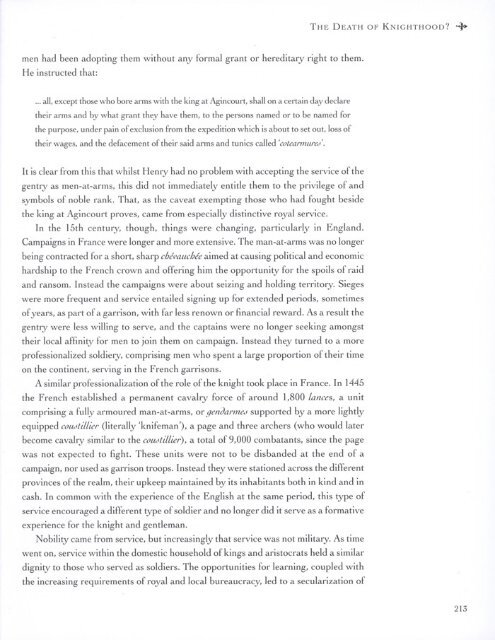Osprey - General Military - Knight - The Warrior and ... - Brego-weard
Osprey - General Military - Knight - The Warrior and ... - Brego-weard
Osprey - General Military - Knight - The Warrior and ... - Brego-weard
You also want an ePaper? Increase the reach of your titles
YUMPU automatically turns print PDFs into web optimized ePapers that Google loves.
men had been adopting them without any formal grant or hereditary right to them.<br />
He instructed that:<br />
... all, except those who bore arms with the king at Agincourt, shall on a certain day declare<br />
their arms <strong>and</strong> by what grant they have them, to the persons named or to be named for<br />
the purpose, under pain of exclusion from the expedition which is about to set out, loss of<br />
their wages, <strong>and</strong> the defacement of their said arms <strong>and</strong> tunics called 'cotearmures'.<br />
It is clear from this that whilst Henry had no problem with accepting the service of the<br />
gentry as men-at-arms, this did not immediately entitle them to the privilege of <strong>and</strong><br />
symbols of noble rank. That, as the caveat exempting those who had fought beside<br />
the king at Agincourt proves, came from especially distinctive royal service.<br />
In the 15th century, though, things were changing, particularly in Engl<strong>and</strong>.<br />
Campaigns in France were longer <strong>and</strong> more extensive. <strong>The</strong> man-at-arms was no longer<br />
being contracted for a short, sharp chevauchee aimed at causing political <strong>and</strong> economic<br />
hardship to the French crown <strong>and</strong> offering him the opportunity for the spoils of raid<br />
<strong>and</strong> ransom. Instead the campaigns were about seizing <strong>and</strong> holding territory. Sieges<br />
were more frequent <strong>and</strong> service entailed signing up for extended periods, sometimes<br />
of years, as part of a garrison, with far less renown or financial reward. As a result the<br />
gentry were less willing to serve, <strong>and</strong> the captains were no longer seeking amongst<br />
their local affinity for men to join them on campaign. Instead they turned to a more<br />
professionalized soldiery, comprising men who spent a large proportion of their time<br />
on the continent, serving in the French garrisons.<br />
A similar professionalization of the role of the knight took place in France. In 1445<br />
the French established a permanent cavalry force of around 1,800 Lances, a unit<br />
comprising a fully armoured man-at-arms, or gendarmes supported by a more lightly<br />
equipped coustillier (literally 'knifeman'), a page <strong>and</strong> three archers (who would later<br />
become cavalry similar to the coustillier), a total of 9,000 combatants, since the page<br />
was not expected to fight. <strong>The</strong>se units were not to be disb<strong>and</strong>ed at the end of a<br />
campaign, nor used as garrison troops. Instead they were stationed across the different<br />
provinces of the realm, their upkeep maintained by its inhabitants both in kind <strong>and</strong> in<br />
cash. In common with the experience of the English at the same period, this type of<br />
service encouraged a different type of soldier <strong>and</strong> no longer did it serve as a formative<br />
experience for the knight <strong>and</strong> gentleman.<br />
Nobility came from service, but increasingly that service was not military. As time<br />
went on, service within the domestic household of kings <strong>and</strong> aristocrats held a similar<br />
dignity to those who served as soldiers. <strong>The</strong> opportunities for learning, coupled with<br />
the increasing requirements of royal <strong>and</strong> local bureaucracy, led to a secularization of<br />
THE DEATH OF KNIGHTHOOD? -3*-<br />
213







